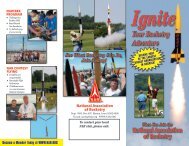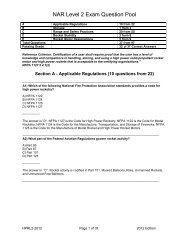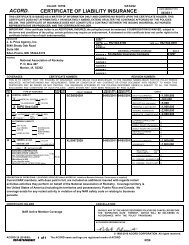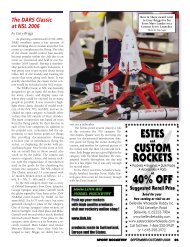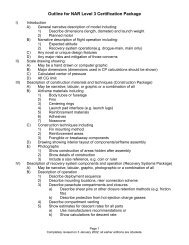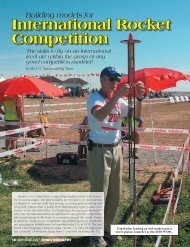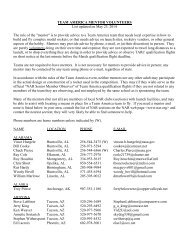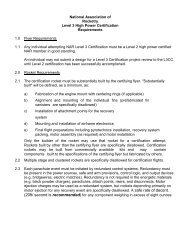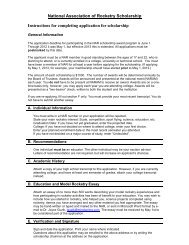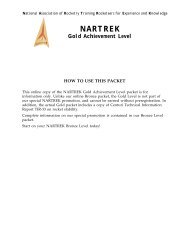Modular rockeTs Building Baffles - National Association of Rocketry
Modular rockeTs Building Baffles - National Association of Rocketry
Modular rockeTs Building Baffles - National Association of Rocketry
You also want an ePaper? Increase the reach of your titles
YUMPU automatically turns print PDFs into web optimized ePapers that Google loves.
Product ReviewQuest AerospaceMLASby Bob SanfordThe completed Quest MLAS model.Manned spaceflight is an inherentlyrisky business. One <strong>of</strong> themost dangerous moments <strong>of</strong> anyspaceflight is the period from ignitionand launch <strong>of</strong> the spacecraft and untilit has reached orbit. Early mannedspacecraft were launched by modifiedmilitary missiles, and theirreliability could not always be100% guaranteed. Boosterssuch as the Saturnseries were so largeand carried somuch propellantthat if somethingshould go wrong the explosion would bedevastating.What was needed was a way to removethe capsule and its crew from a problembooster quickly and in a way that the crewcould survive. Both the United States andSoviet Union space programs used ejectionseats (Vostok, Gemini) or rocket propelledescape towers (Mercury, Soyuz, Apollo).An escape tower was a powerful, solidpropellant rocket motor positioned abovethe space capsule which would ignitequickly in an emergency and pull the capsuleaway from the booster. In the UnitedStates, capsules and escape towers weretested under the Little Joe (Mercury) andLittle Joe II (Apollo) programs.NASA’s Aries 1 rocket and Orion spacecapsule, planned to carry astronauts intoorbit and beyond, also envisioned the use<strong>of</strong> an escape tower. However, another ideafor an escape system for the Orion capsulewas also proposed. NASA’s Engineeringand Safety Center came up with an alternativeescape method utilizing four solidrocket motors affixed around the outside<strong>of</strong> a aerodynamic fairing which would cover/enclosethe Orion capsule. In an emergency,the four solid rocket motors on thefairing would fire to launch the Orion capsuleaway from the Aries rocket.NASA decided to test parts <strong>of</strong> thisconcept under the project name <strong>of</strong> MaxLaunch Abort System (MLAS). Accordingto information on the NASA website,“A Primary objective <strong>of</strong> the MLAS test isto provide the NASA workforce with additionaldirect implementation experiencein flight testing a spacecraft concept usefulin the Agency’s future efforts to design,optimize, and test spacecraft.” The actualtests would begin after motor burnout.“The test is primarily a demonstration <strong>of</strong>unpowered flight along a stable trajectory,MLAS vehicle reorientation and stabilization,followed by crew module simulatorseparation from the MLAS fairing, stabilizationand the parachute recovery <strong>of</strong> thecrew module simulator.”I think some folks at NASA just wantedto fly a really cool rocket.The actual MLAS rocket stood just over33 feet high, weighed 45,000 pounds andwas successfully flown in the early morning<strong>of</strong> July 8, 2009, from NASA’s WallopsFlight Facility, Wallops Island, Virginia.In a display <strong>of</strong> rapid prototyping andproduction, a representative <strong>of</strong> QuestAerospace announced on a web forum thatthe company was working on a sport-scalemodel <strong>of</strong> the MLAS only two days after theflight <strong>of</strong> the actual MLAS. Less than a monthlater at NARAM-51, Quest displayed a finishedMLAS prototype at the Manufacturers’Forum and began shipping their MLASmodel in early November, 2009.The Quest MLAS is a sport-scale model,which means some concessions weremade for flight stability and production issues.Even so, this model has a great deal<strong>of</strong> appeal to rocketeers. The MLAS modelhas several unique features and will requirethe modeler to work with different materials,which explains why this kit is rated asa Skill Level 3. Thanks to the well-writteninstructions a modeler with several SkillLevel 1 and 2 kits to their credit will beable to assemble and fly this model.The Quest MLAS comes packaged in asturdy white-colored box with a full colorwrap-around label. Pictures <strong>of</strong> the actual16 MAY/JUNE 2010 Sport <strong>Rocketry</strong>




